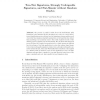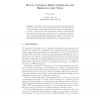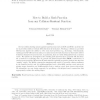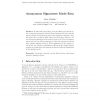52 search results - page 2 / 11 » How Risky Is the Random-Oracle Model |
IJSN
2006
13 years 4 months ago
2006
In this paper, we propose a new signature scheme that is existentially unforgeable under a chosen message attack without random oracle. The security of our scheme depends on a new ...
PKC
2007
Springer
13 years 11 months ago
2007
Springer
We provide a positive result about the Fiat-Shamir (FS) transform in the standard model, showing how to use it to convert threemove identification protocols into two-tier signatur...
CRYPTO
2004
Springer
13 years 10 months ago
2004
Springer
Ordinarily, RSA and Rabin ciphertexts and signatures are log N bits, where N is a composite modulus; here, we describe how to “compress” Rabin ciphertexts and signatures (among...
ASIACRYPT
2007
Springer
13 years 11 months ago
2007
Springer
Recent collision-finding attacks against hash functions such as MD5 and SHA-1 motivate the use of provably collision-resistant (CR) functions in their place. Finding a collision ...
PKC
2007
Springer
13 years 11 months ago
2007
Springer
Abstract. At PKC 2006, Yang, Wong, Deng and Wang proposed the notion of anonymous signature schemes where signatures do not reveal the signer’s identity, as long as some parts of...




